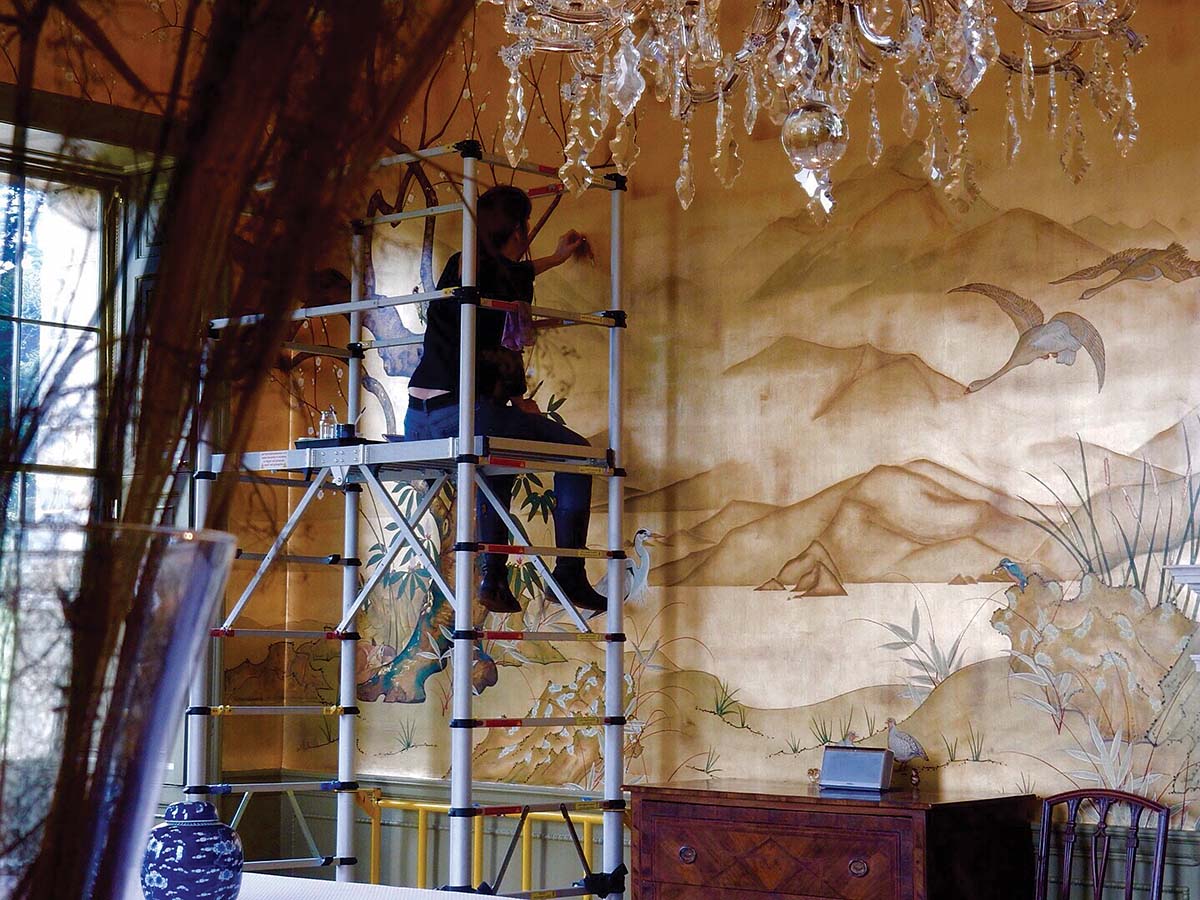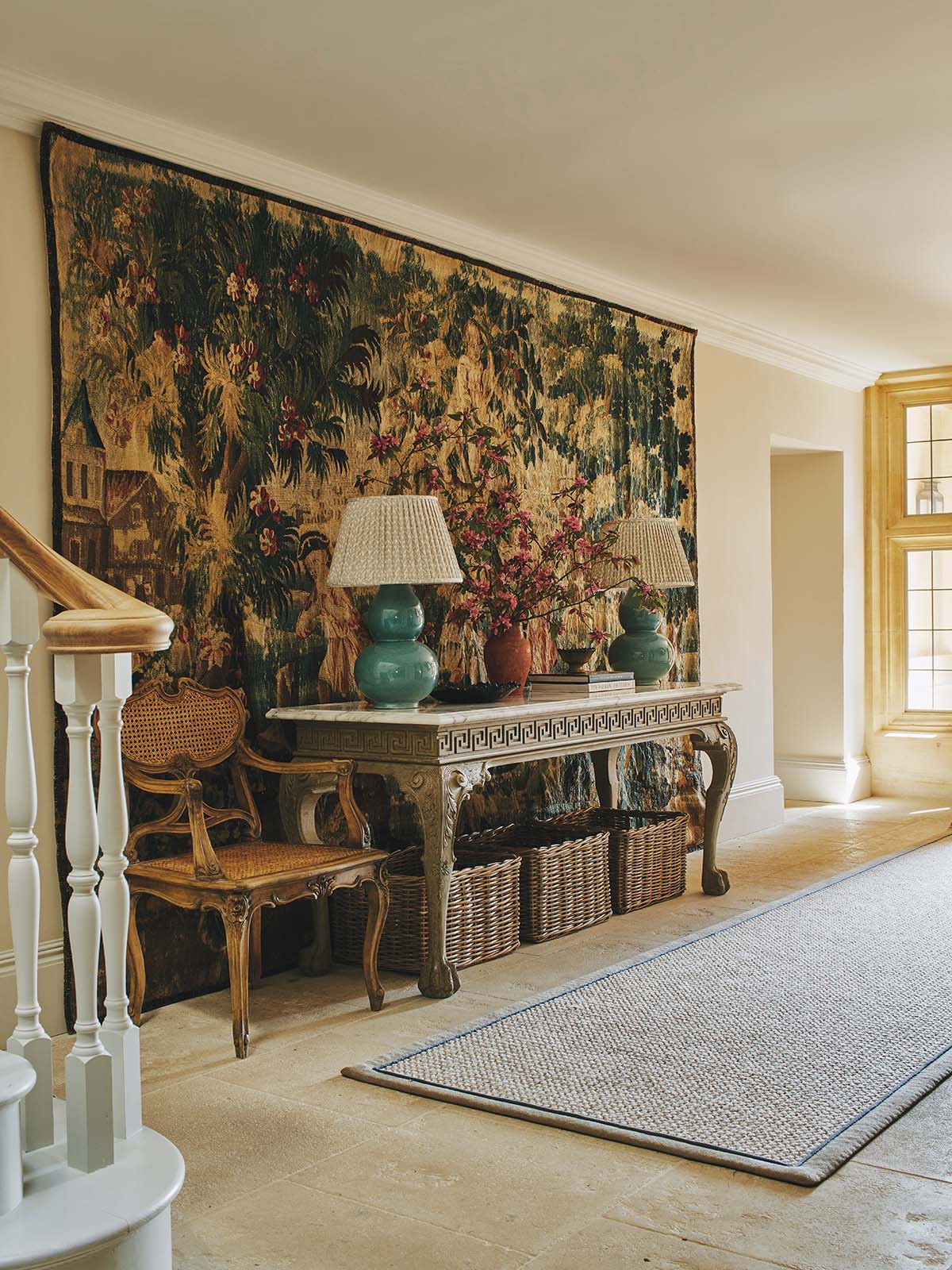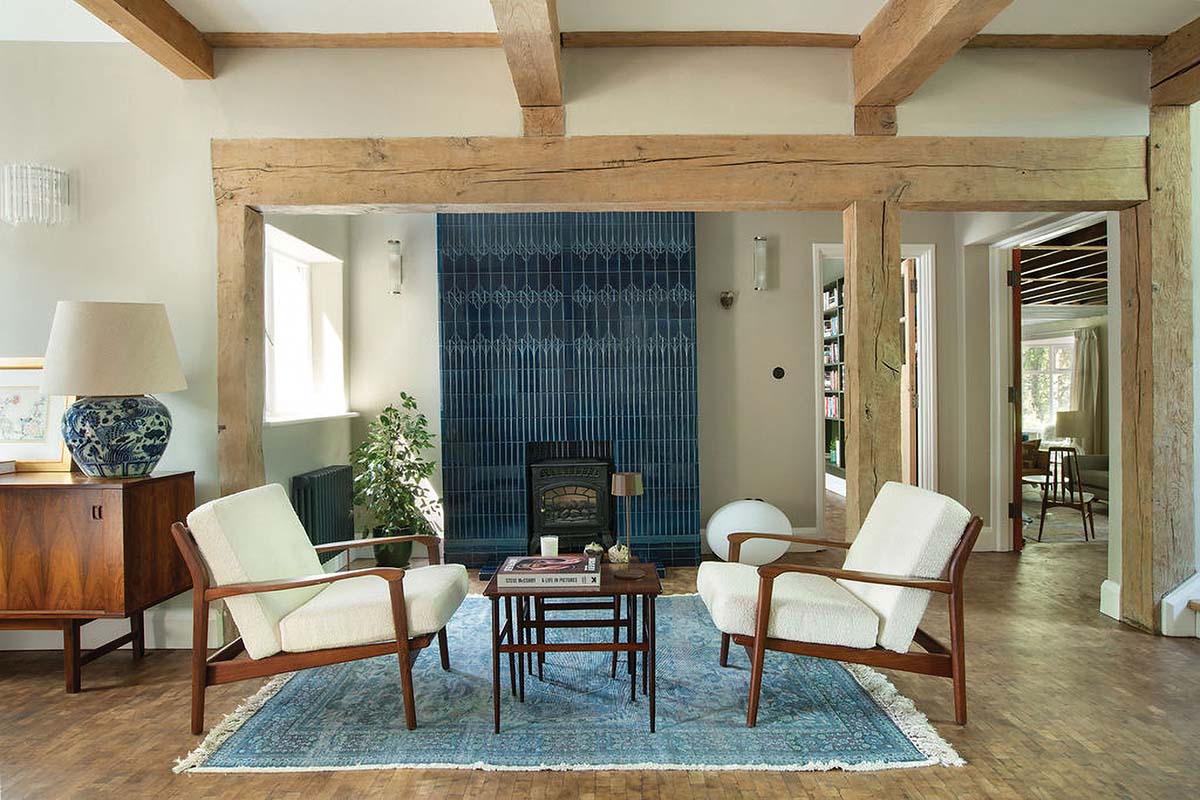Tiles, tapestries, murals, plasterwork… there are so many ways to liven up walls, so why do we struggle to see beyond paint and paper?
Look at one of the walls in front of you. I’ll hazard a guess it is painted in one carefully chosen colour that won the battle of the swatches (and the battle of competing tastes, should your household be bustling with Opinions). If you’re a plucky sort, you’ve taken the plunge and gone for wallpaper in a repeating print instead. Perhaps there are framed photos or art to break it up a bit. What else can you do with a wall? A lot, actually. So it is curious that in this era of hyperpersonalisation, as we all seek to break away from algorithmic design and unearth new forms of expression in our homes, we continue to limit ourselves when confronted with the ultimate blank canvas. Paint and wallpaper aren’t the only ways to add colour and texture to a wall, you know.

If you live in a period home then perhaps your rooms already benefit from the sense of depth that cornicing and picture rails bestow. If not, and things are looking a little flat and boxy, there are several ways to introduce dimension to your walls. Timber panelling has grown in popularity lately, particularly tongue-and-groove planks and slender fluted strips. Companies such as Naturewall sell them as individual slats or as panels; lay them floor-to-ceiling or take them midway up the walls. Or if ornamental plasterwork is more your bag and you’d like a contemporary take on it, check out Fife-based specialists Chalk Plaster, who combine traditional methods with geometric designs.
Then there are tiles, which aren’t just for kitchens or bathrooms. On the far left is a sunroom wall covered in 3D terracotta tiles to create the effect of a textured relief mural. “It brought warmth and felt like a modern way to clad the surface,” says interior designer Alicia Meireles of Own London, who worked on the project. “By not adding grout between the tiles, we created an uninterrupted design.”
Even within the realm of paint and wallpaper there are ways to break the mould: rhythmic motifs painted directly on a walls, as in the work of Glasgow-based artist Flore de Hoog, or wallpaper that has been block-printed by hand. That’s what printmaker Nicholas Hughes does in his London studio. He reckons part of the charm of his characterful designs comes from their slight variations. “All the most beautiful wallcoverings in history were handmade,” he says. “They’re all imperfect, a bit wonky, but all the other stuff in your house sits way more comfortably with it.”
1. Plaster remaster

Plaster has featured in our homes for centuries – millennia, even – and lately it’s been enjoying a resurgence. The specialist plasterer Daniel Sheppard of Unico Venetian has noticed a rise in demand for clay and Venetian plasterwork, as well as microcement, each of which can be ordered in a variety of colours and finishes to produce different results.
“Venetian plaster is made of slaked lime and crushed marble and is really versatile – the marble dust could be extremely fine or a heavier aggregate, depending on the look you want to go for,” he says. Typically it is used to replicate the appearance of stones such as travertine or marble. It isn’t suitable for floors or wet rooms, though, so save it for living and sleeping areas. Or consider clay plaster. Like Venetian, it’s a natural, eco-friendly material and can be pebble-smooth or coarser-grained. Daniel uses Clayworks, widely regarded as the gold standard in walls design.
“The good thing with clay is that it can be repaired easily without there being a visible patch,” he says.
Again, you wouldn’t want to use it in a bathroom, and because of its crumbly nature Daniel advises applying a protective glaze. He thinks it looks best in large, well-lit rooms where the nuances of its patina can be appreciated. Microcement is less restrictive. It is waterproof, stain-resistant and works pretty much anywhere. You probably associate it most with a dove-grey, brushed-suede finish but it’s more adaptable than you think. Forcrete, the supplier Daniel uses, offers various colours and finishes and even does metallic sealers for a glamorous effect.
Our tip? Hire an expert; specialist finishes demand familiarity with the materials and a sure hand.
2. Lasting impression

A love of classical friezes and 18th-century art and architecture led Katy Eccles of Imprint Casts to her practice of creating delicate botanical plaster casts. Recently the artist has progressed from making smaller decorative pieces to larger-scale panels that can be stacked to cover a wider expanse of wall. “It’s almost a blend of sculpture and wall art,” she explains. One of her first big pieces involved casting a client’s wedding bouquet, which she divided into four panels. These days she would perhaps do this as one big piece. Irrespective of size, the process is the same: her homegrown flowers are plucked, rolled into damp clay, then carefully removed, petal by petal. The cast air-dries for around ten to 12 weeks before it is ready to be wall-mounted. “I also love to see them hung from a picture rail,” she adds.
As well as experimenting with scale, Katy has started incorporating classical urns into her designs, from which the flowers spill out. “A bit like a Dutch Vanitas or a still-life,” she says. “They are more inspired by architectural ornamentation so they could be fitted within a plasterwork scheme rather than hung on their own.” This new style on walls will launch later this year.
3. Strokes of design

If you really want to pull out all the stops, how about a hand-painted mural? Doing it yourself might result in a Fresco Jesus situation, so make like all the top interior designers in Scotland and give Rachel Bell and Corneilius Pierce a call.
The couple, who work under the name Mr & Mrs Bell Art and Design, are multi-talented, highly versatile artists who restore historic artworks and also paint their own pieces, either directly on to walls or on large-scale canvases (the benefit of the latter being that you can bring the art with you if you move house). “Our aspiration is for our work to be the art being restored in 100 years’ time,” laughs Corneilius.
The artists like to get to know a client first of all: their personalities, tastes, what they’re into, as well as their decor scheme. “Then we throw it all into a cauldron, if you like,” says Corneilius. Next, they’ll mock up a custom design, then tweak it until the client is happy before getting their brushes out.
No work is the same: it’s a very personal thing. Some people will ask to have flowers scrambling up their walls; others may request something a bit more esoteric. “We’re obsessed with painting on gilded surfaces at the moment,” says Rachel. A recent job involved covering the four walls of a huge dining room in Fife with 40,000 sheets of gold leaf, which served as a decadent backdrop for a Japanese-based illustration with a Scottish twist. “We call it Scotto-Japanese; it has become a signature of ours.”
Some of their jobs will take several months to complete and you can expect to pay accordingly. “It’s a lot of work, and we put our heart and soul into it,” says Corneilius. “But we charge a fair price which is fixed from the outset because we know how a lot of trades work; often things cost more in the end, and we don’t like doing that.”
Simpler designs are less time-consuming and may suit those with a more modest budget. “For one drawing room, all we had to do was paint a couple of gold cranes flying around the room,” says Rachel. “It wasn’t expensive – but it looks it.”

You might associate tapestries with fusty castles and old country piles, but it’s time for a rethink. Woven wall coverings are making their way into modern domestic settings and have an entirely different vibe when mixed with contemporary furnishings. They add warmth, textural richness and instant impact: just look at the way design studio Sims Hilditch has used a French Aubusson tapestry (pictured below) to transform this hallway into a place worth pausing in. If you want something similar, keep an eye out in auctions and antiques shops for French or Flemish pieces.
But remember this isn’t the only style in existence. The weavers at Dovecot Studios in Edinburgh create contemporary tapestries with internationally renowned artists and have woven works by Elizabeth Blackadder, David Hockney and Alberta Whittle. “Our aims are inspired by Arts & Crafts principles whereby the lives of ordinary people can be enriched by decoration, fine art and the hand-made,” says Dovecot’s director, Celia Joicey. The studio recently created a tapestry based on a piece by Glasgow-born painter Kaye Donachie for the new Soho Mews House in London. If that’s not proof of tapestry’s renaissance, we don’t know what is.
5. Glaze over

We are programmed in this country to have tunnel vision when it comes to tiles, confining them to the more practical rooms of the house because, well, that’s what we do, isn’t it? When we do let them out of our bathrooms, it’s because we’re allowing them a moment of glory on a kitchen floor. But nothing is stopping you from using them on a feature wall in your living room; if you have a fireplace, that’s an ideal point to start from.
Shown above is a roomy hallway in an Arts & Crafts house, where the tiled fireplace surround has been extended to cover the centre of one of the walls in this room. “These tiles, with their distinctive deep blue glaze and Art Nouveau design, captured my imagination long before I had the chance to apply them in practice,” says Lolita Colenso, who designed the interiors. “I wanted them to have the effect of a mural in a bath house or a theatre, and to create a focal point of timeless drama that would be admired for years to come.” Alicia Meireles of Own London, who designed the terracotta tile walls seen on page 52, advises being mindful of how heavy the tiles are.
“You will probably need some support at the back,” she warns. “And if you’re going to have any paintings or mirrors hanging from tiled walls, pre-drill some of the tiles so that you don’t have to drill them in situ, in case they crack.”
Not brave enough to do a full wall? Try framing a doorway with a single layer of tiles for a pleasing hit of pattern.





